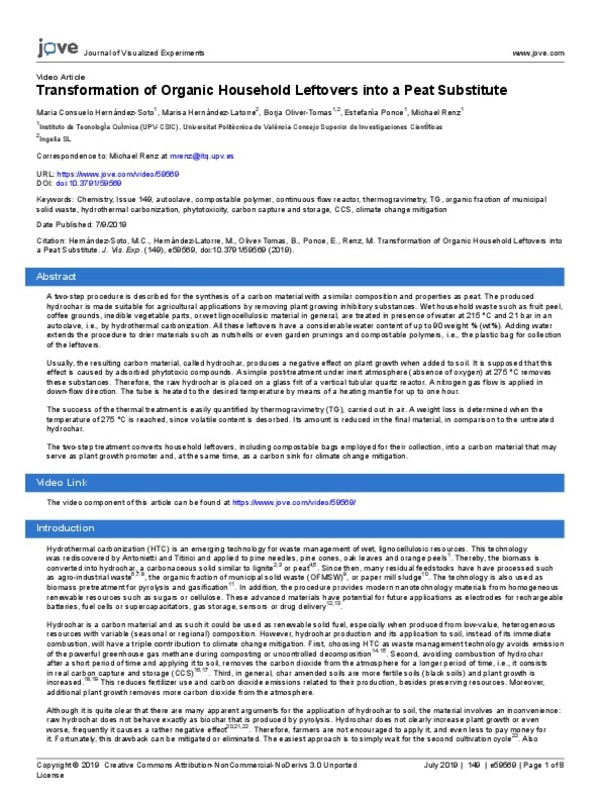JavaScript is disabled for your browser. Some features of this site may not work without it.
Buscar en RiuNet
Listar
Mi cuenta
Estadísticas
Ayuda RiuNet
Admin. UPV
Transformation of Organic Household Leftovers into a Peat Substitute
Mostrar el registro sencillo del ítem
Ficheros en el ítem
| dc.contributor.author | Hernández-Soto, Maria Consuelo
|
es_ES |
| dc.contributor.author | Hernández-Latorre, Marisa
|
es_ES |
| dc.contributor.author | Oliver-Tomás, Borja
|
es_ES |
| dc.contributor.author | Ponce, Estefanía
|
es_ES |
| dc.contributor.author | Renz, Michael
|
es_ES |
| dc.date.accessioned | 2021-01-15T04:31:26Z | |
| dc.date.available | 2021-01-15T04:31:26Z | |
| dc.date.issued | 2019-07 | es_ES |
| dc.identifier.uri | http://hdl.handle.net/10251/159138 | |
| dc.description.abstract | [EN] A two-step procedure is described for the synthesis of a carbon material with a similar composition and properties as peat. The produced hydrochar is made suitable for agricultural applications by removing plant growing inhibitory substances. Wet household waste such as fruit peel, coffee grounds, inedible vegetable parts, or wet lignocellulosic material in general, are treated in presence of water at 215 degrees C and 21 bar in an autoclave, i.e., by hydrothermal carbonization. All these leftovers have a considerable water content of up to 90 weight % (wt%). Adding water extends the procedure to drier materials such as nutshells or even garden prunings and compostable polymers, i.e., the plastic bag for collection of the leftovers. Usually, the resulting carbon material, called hydrochar, produces a negative effect on plant growth when added to soil. It is supposed that this effect is caused by adsorbed phytotoxic compounds. A simple post-treatment under inert atmosphere (absence of oxygen) at 275 degrees C removes these substances. Therefore, the raw hydrochar is placed on a glass frit of a vertical tubular quartz reactor. A nitrogen gas flow is applied in down-flow direction. The tube is heated to the desired temperature by means of a heating mantle for up to one hour. The success of the thermal treatment is easily quantified by thermogravimetry (TG), carried out in air. A weight loss is determined when the temperature of 275 degrees C is reached, since volatile content is desorbed. Its amount is reduced in the final material, in comparison to the untreated hydrochar. The two-step treatment converts household leftovers, including compostable bags employed for their collection, into a carbon material that may serve as plant growth promoter and, at the same time, as a carbon sink for climate change mitigation. | es_ES |
| dc.description.sponsorship | The Authors are grateful for the financial support received from the European Commission under the CharM and AdvCharM of the Climate-KIC Programme and from the Spanish Ministry of Science, Innovation and Universities under RTC-2017-6087-5 of the "Investigacion, Desarrollo e Innovacion Orientada a los Retos de la Sociedad" Programme and under the Severo Ochoa program (SEV-2016-0683). | es_ES |
| dc.language | Inglés | es_ES |
| dc.publisher | Journal of Visualized Experiments | es_ES |
| dc.relation.ispartof | Journal of Visualized Experiments | es_ES |
| dc.rights | Reconocimiento - No comercial - Sin obra derivada (by-nc-nd) | es_ES |
| dc.subject | Chemistry | es_ES |
| dc.subject | Issue 149 | es_ES |
| dc.subject | Autoclave | es_ES |
| dc.subject | Compostable polymer | es_ES |
| dc.subject | Continuous flow reactor,thermogravimetry | es_ES |
| dc.subject | TG | es_ES |
| dc.subject | Organic fraction of municipal solid waste | es_ES |
| dc.subject | Hydrothermal carbonization | es_ES |
| dc.subject | Phytotoxicity | es_ES |
| dc.subject | Carbon capture and storage | es_ES |
| dc.subject | CCS | es_ES |
| dc.subject | Climate change mitigation | es_ES |
| dc.subject.classification | QUIMICA ANALITICA | es_ES |
| dc.subject.classification | QUIMICA INORGANICA | es_ES |
| dc.title | Transformation of Organic Household Leftovers into a Peat Substitute | es_ES |
| dc.type | Artículo | es_ES |
| dc.identifier.doi | 10.3791/59569 | es_ES |
| dc.relation.projectID | info:eu-repo/grantAgreement/MINECO//SEV-2016-0683/ | es_ES |
| dc.relation.projectID | info:eu-repo/grantAgreement/AEI//RTC-2017-6087-5/ES/Transformación termoquímica de hydrochar para productos de alto valor, optimización de productos y proceso en un reactor de partículas/ | es_ES |
| dc.rights.accessRights | Abierto | es_ES |
| dc.contributor.affiliation | Universitat Politècnica de València. Instituto Universitario Mixto de Tecnología Química - Institut Universitari Mixt de Tecnologia Química | es_ES |
| dc.description.bibliographicCitation | Hernández-Soto, MC.; Hernández-Latorre, M.; Oliver-Tomás, B.; Ponce, E.; Renz, M. (2019). Transformation of Organic Household Leftovers into a Peat Substitute. Journal of Visualized Experiments. (149):1-8. https://doi.org/10.3791/59569 | es_ES |
| dc.description.accrualMethod | S | es_ES |
| dc.relation.publisherversion | https://doi.org/10.3791/59569 | es_ES |
| dc.description.upvformatpinicio | 1 | es_ES |
| dc.description.upvformatpfin | 8 | es_ES |
| dc.type.version | info:eu-repo/semantics/publishedVersion | es_ES |
| dc.description.issue | 149 | es_ES |
| dc.identifier.eissn | 1940-087X | es_ES |
| dc.relation.pasarela | S\406153 | es_ES |
| dc.contributor.funder | EIT Climate-KIC | es_ES |
| dc.contributor.funder | Agencia Estatal de Investigación | es_ES |
| dc.contributor.funder | Ministerio de Economía y Competitividad | es_ES |








